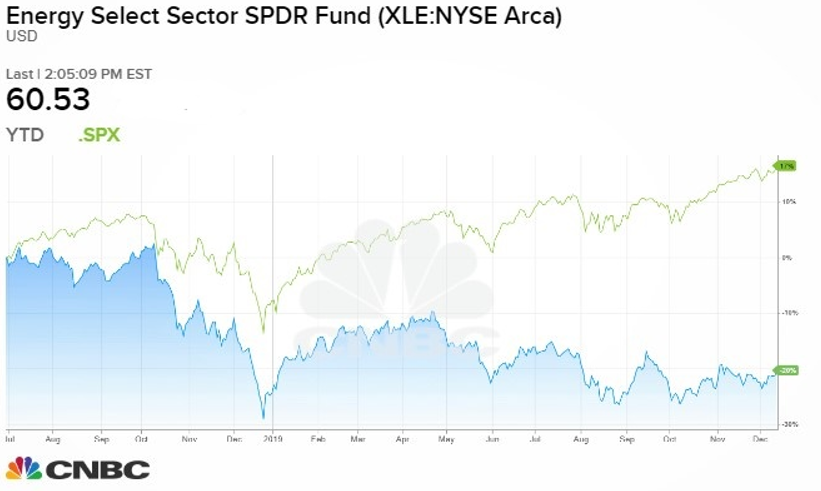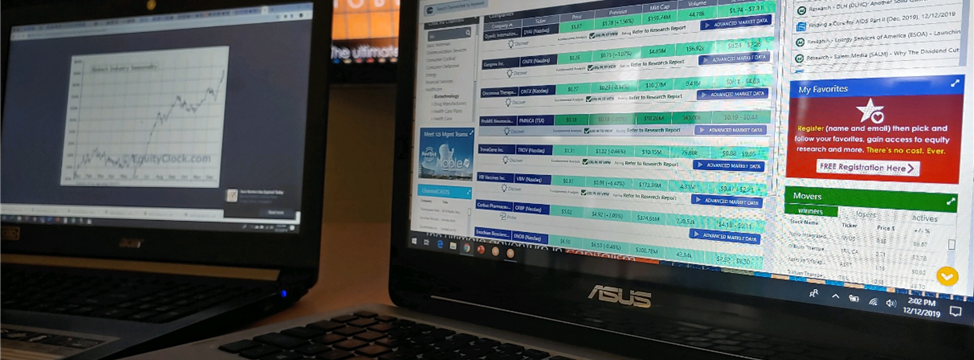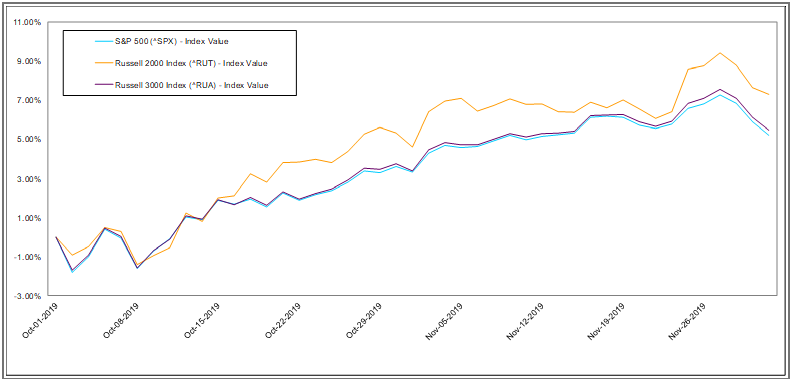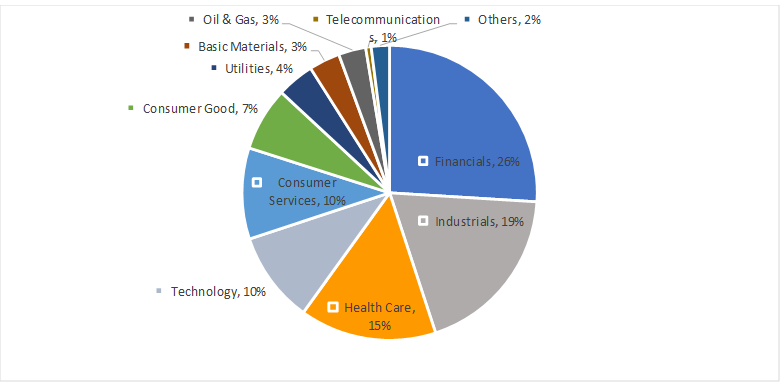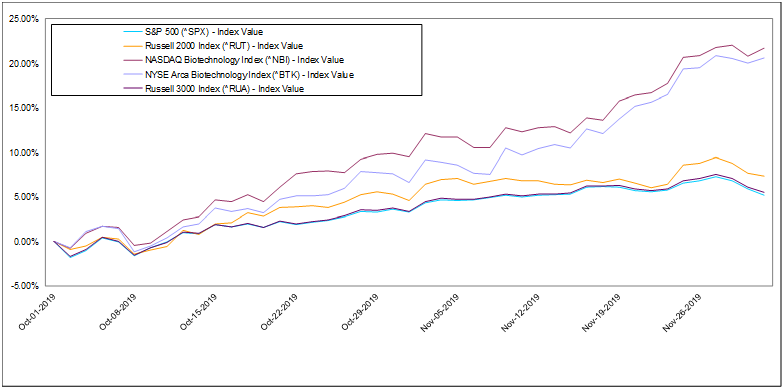
Wednesday, January 8, 2020
Energy Industry Report
Exploration and Production: 2019 Review and Outlook
Michael Heim, CFA, Senior Research Analyst, Noble Capital Markets, Inc.
Refer to end of report for Analyst Certification & Disclosures
- End of a difficult year. Energy stocks rallied in the fourth quarter and ended the year up 1.8%, well underperforming the broad market. Weak results mirror the change in oil prices. Oil prices rose from $54 per barrel to $62/BBL in the fourth quarter in response to an improved global economic outlook and growing tension in the Middle East but were down for the year. The oil futures curve indicates that the market does not expect a recent rise in spot prices to continue. Natural gas prices were also weak in 2019.
- The outlook for energy stocks has improved but it is too early to turn positive. We continue to believe that oil prices are locked in a range of $50-$65 per barrel, a range that puts pressure on energy companies with high debt positions. Any movement outside that range will cause domestic producers to react by increasing/decreasing drilling and thus production which will eventually move prices back into the range. While too early to become positive on the group, we believe investors should maintain a modest exposure to energy stocks as a way to play any potential rise in energy prices.
Year and quarter in review
Exploration and production companies were glad to see the ball drop on 2019 and close out a frustrating year. A strong performance in the fourth quarter (XLE E&P index rose 6.9%) offset declines in the second and third quarter and left the index in the green (up 1.8%) for the year. Of course, this performance paled in comparison to the annual returns of the broader market (S&P 500 up 26.7% and the Russell 2000 up 18.7%). As expected, the performance of the XLE mirrored oil prices, which rose in the first quarter, fell in the second and third, and then rose again in the fourth. The rise in the February 2020 oil contract rose from $54 per barrel to $62/BBL in the fourth quarter in response to an improved global economic outlook and growing tension in the Middle East.
The market seems to be dismissing the long-term impact of the president’s political saber rattling with Iran. We would note that future oil prices are below the current spot price. Clearly the market has grown weary of the constant threats of war by both countries and discounts the probability of war. Or, as we have discussed in the past, the market realizes the diminished role OPEC and the Middle East now have on West Texas Intermediate oil pricing.
When companies report December quarter and year-end results next month, we expect most management to report an increase in their hedge position and an increase in their drilling budgets. Most energy companies still set capital expenditures to stay within their operating cash flow but are anxious to turn on the spigots. With higher prices and cash flow, look for modest increases in drilling.
If energy investors are looking away from oil for relief, they won’t get any help from gas producers. The February Henry Hub natural gas contract began the year near $3.00 per thousand cubic feet (mcf) and closed the year at $2.19 per mcf. The year’s decline was largely felt in the last two months of the year when the contract fell $0.67 in response to mild weather.
Outlook
As we look towards the new year, the outlook for energy stocks is improved but not yet positive. We continue to believe that oil prices are essentially locked in a range of $50-$65 per barrel. Any movement outside that range will cause domestic producers to react by increasing/decreasing drilling and thus production which will eventually move prices back into the range. We view the current movement to the upper end of the range as driven largely by political events and thus temporary.
Unfortunately, at prices within the $50-$65 range, most small energy companies are struggling to operate within free cash flow. They have cut operating costs, restructured debt, and focused on only the most profitable areas of production. Those with high leverage are vulnerable to line of credit downgrades that could create financial strain.
We favor energy companies with a large portfolio of drilling prospects and a strong balance sheet to fund future drilling or other expenditures. We believe energy companies with strong financial positions could begin to consider share repurchases in 2020 if energy prices remain strong and stock prices have not responded. While too early to become positive on the group, we believe investors should maintain a modest exposure to energy stocks as a way to play any potential rise in energy prices.
GENERAL DISCLAIMERS
All statements or opinions contained herein that include the words “we”, “us”, or “our” are solely the responsibility of Noble Capital Markets, Inc.(“Noble”) and do not necessarily reflect statements or opinions expressed by any person or party affiliated with the company mentioned in this report. Any opinions expressed herein are subject to change without notice. All information provided herein is based on public and non-public information believed to be accurate and reliable, but is not necessarily complete and cannot be guaranteed. No judgment is hereby expressed or should be implied as to the suitability of any security described herein for any specific investor or any specific investment portfolio. The decision to undertake any investment regarding the security mentioned herein should be made by each reader of this publication based on its own appraisal of the implications and risks of such decision.
This publication is intended for information purposes only and shall not constitute an offer to buy/sell or the solicitation of an offer to buy/sell any security mentioned in this report, nor shall there be any sale of the security herein in any state or domicile in which said offer, solicitation or sale would be unlawful prior to registration or qualification under the securities laws of any such state or domicile. This publication and all information, comments, statements or opinions contained or expressed herein are applicable only as of the date of this publication and subject to change without prior notice. Past performance is not indicative of future results. Noble accepts no liability for loss arising from the use of the material in this report, except that this exclusion of liability does not apply to the extent that such liability arises under specific statutes or regulations applicable to Noble. This report is not to be relied upon as a substitute for the exercising of independent judgement. Noble may have published, and may in the future publish, other research reports that are inconsistent with, and reach different conclusions from, the information provided in this report. Noble is under no obligation to bring to the attention of any recipient of this report, any past or future reports. Investors should only consider this report as single factor in making an investment decision.
IMPORTANT DISCLOSURES
This publication is confidential for the information of the addressee only and may not be reproduced in whole or in part, copies circulated, or discussed to another party, without the written consent of Noble Capital Markets, Inc. (“Noble”). Noble seeks to update its research as appropriate, but may be unable to do so based upon various regulatory constraints. Research reports are not published at regular intervals; publication times and dates are based upon the analyst’s judgement. Noble professionals including traders, salespeople and investment bankers may provide written or oral market commentary, or discuss trading strategies to Noble clients and the Noble proprietary trading desk that reflect opinions that are contrary to the opinions expressed in this research report.
The majority of companies that Noble follows are emerging growth companies. Securities in these companies involve a higher degree of risk and more volatility than the securities of more established companies. The securities discussed in Noble research reports may not be suitable for some investors and as such, investors must take extra care and make their own determination of the appropriateness of an investment based upon risk tolerance, investment objectives and financial status.
Company Specific Disclosures
The following disclosures relate to relationships between Noble and the company (the “Company”) covered by the Noble Research Division and referred to in this research report.
Noble is not a market maker in any of the companies mentioned in this report. Noble intends to seek compensation for investment banking services and non-investment banking services (securities and non-securities related) with any or all of the companies mentioned in this report within the next 3 months
ANALYST CREDENTIALS, PROFESSIONAL DESIGNATIONS, AND EXPERIENCE
Senior Equity Analyst focusing on Basic Materials & Mining. 20 years of experience in equity research. BA in Business Administration from Westminster College. MBA with a Finance concentration from the University of Missouri. MA in International Affairs from Washington University in St. Louis.
Named WSJ ‘Best on the Street’ Analyst and Forbes/StarMine’s “Best Brokerage Analyst.”
FINRA licenses 7, 24, 63, 87
WARNING
This report is intended to provide general securities advice, and does not purport to make any recommendation that any securities transaction is appropriate for any recipient particular investment objectives, financial situation or particular needs. Prior to making any investment decision, recipients should assess, or seek advice from their advisors, on whether any relevant part of this report is appropriate to their individual circumstances. If a recipient was referred to Noble Capital Markets, Inc. by an investment advisor, that advisor may receive a benefit in respect of
transactions effected on the recipients behalf, details of which will be available on request in regard to a transaction that involves a personalized securities recommendation. Additional risks associated with the security mentioned in this report that might impede achievement of the target can be found in its initial report issued by Noble Capital Markets, Inc.. This report may not be reproduced, distributed or published for any purpose unless authorized by Noble Capital Markets, Inc..
RESEARCH ANALYST CERTIFICATION
Independence Of View
All views expressed in this report accurately reflect my personal views about the subject securities or issuers.
Receipt of Compensation
No part of my compensation was, is, or will be directly or indirectly related to any specific recommendations or views expressed in the public
appearance and/or research report.
Ownership and Material Conflicts of Interest
Neither I nor anybody in my household has a financial interest in the securities of the subject company or any other company mentioned in this report.
| NOBLE RATINGS DEFINITIONS |
% OF SECURITIES COVERED |
% IB CLIENTS |
| Outperform: potential return is >15% above the current price |
86% |
25% |
| Market Perform: potential return is -15% to 15% of the current price |
14% |
2% |
| Underperform: potential return is >15% below the current price |
0% |
0% |
NOTE: On August 20, 2018, Noble Capital Markets, Inc. changed the terminology of its ratings (as shown above) from “Buy” to “Outperform”, from “Hold” to “Market Perform” and from “Sell” to “Underperform.” The percentage relationships, as compared to current price (definitions), have remained the same. Additional information is available upon request. Any recipient of this report that wishes further information regarding the subject company or the disclosure information mentioned herein, should contact Noble Capital Markets, Inc. by mail or phone.
Noble Capital Markets, Inc.
225 NE Mizner Blvd. Suite 150
Boca Raton, FL 33432
561-994-1191
Noble Capital Markets, Inc. is a FINRA (Financial Industry Regulatory Authority) registered broker/dealer.
Noble Capital Markets, Inc. is an MSRB (Municipal Securities Rulemaking Board) registered broker/dealer.
Member – SIPC (Securities Investor Protection Corporation)
Report ID: 11091








